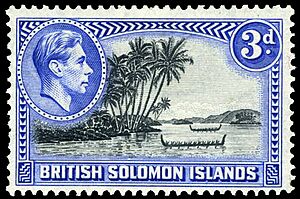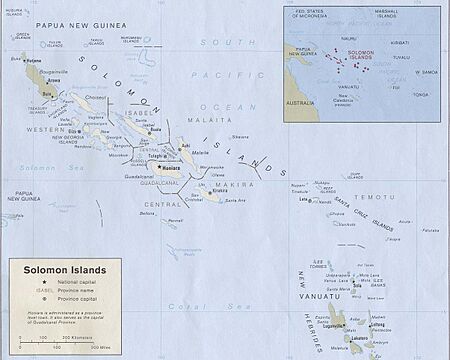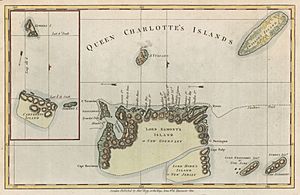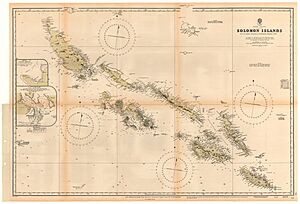History of Solomon Islands facts for kids
The Solomon Islands is a country in the western Pacific Ocean, located in a region called Melanesia. This page tells you about the history of the country itself, not the larger group of islands that also includes Bougainville Island (which is part of Papua New Guinea).
Contents
First People in the Solomon Islands
The first people arrived in the Solomon Islands about 30,000 years ago. They came from New Guinea. These early settlers were the first humans to reach this far into the Pacific.
Around 4000 BC, new groups of people arrived. They spoke Austronesian languages and brought new ways of farming and sailing. Most of the languages spoken in the Solomon Islands today come from this time. However, about thirty languages from the first settlers are still spoken.
There are many old cultural sites from before Europeans arrived. These include the Bao megalithic shrine (from the 1200s) and the Nusa Roviana fortress and shrines (from the 1300s to 1800s). There is also Vonavona Skull Island. These sites are all in the Western Province.
The Nusa Roviana fortress and nearby villages were a busy center for trade from the 1600s to the 1800s. The skull shrines of Nusa Roviana are part of old legends. One famous story is about the Tiola shrine, where a stone dog would turn to show where enemies were coming from. These ancient sites show how the local Roviana culture grew strong through trade and expeditions in the 1600s and 1700s.
European Explorers Arrive
In 1568, Spanish explorer Álvaro de Mendaña de Neira and his ships first saw Santa Isabel island. They found signs of gold on Guadalcanal. Mendaña thought he had found the source of King Solomon's riches, so he named the islands "The Islands of Solomon."
Spain tried to send more trips to find the islands and start a colony in 1595 and 1605, but they were not successful. Later, in 1767, Commander Philip Carteret rediscovered the Santa Cruz Islands and Malaita. Other explorers from the Netherlands, France, and Britain also visited the islands. The islanders often did not welcome them.
Christian missionaries started visiting the islands in the 1840s. French Catholics tried to set up a mission on Santa Isabel Island, but it was stopped after Jean-Baptiste Epalle was killed by islanders in 1845. Anglican missionaries began arriving in the 1850s, followed by other groups. Over time, many islanders became Christians.
Becoming a Colony

In 1856, Sikaiana (then called the Stewart Islands) became part of the Hawaiian Kingdom. However, Hawaii did not make this official. When the United States took over Hawaii in 1898, they did not recognize Hawaii's claim over Sikaiana.
The German Empire wanted to expand its power. In 1886, Germany and the United Kingdom agreed on "spheres of influence" in the Pacific. Germany then set up a protectorate (a protected area) over the North Solomon Islands. This area included parts of what is now the Solomon Islands. Germany gave up its claim to the southern Solomon Islands.
In June 1893, Captain Herbert William Sumner Gibson of HMS Curacoa declared the southern Solomon Islands a British protectorate. This meant Britain would protect and control the islands.
Britain did not immediately send administrators to the Solomon Islands. The islands became part of the British Western Pacific Territories, which was managed by a high commissioner living in Fiji.
Charles Morris Woodford was appointed as the British Resident Commissioner for the Solomon Islands in 1897. His job was to control the trade of workers (sometimes called "blackbirding") and stop the illegal trade of guns. In 1898, Arthur William Mahaffy became Woodford's deputy. In 1900, Mahaffy set up a government station in Gizo. He was chosen because his military training made him suitable for stopping headhunting in New Georgia and nearby islands.
In 1898, Britain also took control of the Santa Cruz Islands and the Rennell and Bellona Islands. In 1900, Germany gave Choiseul Island, Santa Isabel Island, the Shortland Islands, and Ontong Java Atoll to the British Solomon Islands Protectorate. This was part of an agreement where Britain gave up its claims to Western Samoa. Germany kept Bougainville and its surrounding islands.
In 1927, District Commissioner William R. Bell was killed on Malaita, along with a cadet and 13 Solomon Islanders. A large military response followed, known as the Malaita massacre. At least 60 Kwaio people were killed, nearly 200 were arrested in Tulagi (the capital), and many sacred sites were destroyed.
World War II in the Islands

In January 1942, Japanese forces took over the North Solomon Islands, which were part of Australia's Territory of New Guinea. They then moved south to Tulagi. The United States led the counter-attack. In August 1942, the 1st Division of the US Marines landed on Guadalcanal and Tulagi. Some of the toughest fighting of World War II happened on these islands for almost three years.
Tulagi, where the British administration was located, was destroyed in the heavy fighting. The difficult battle for Guadalcanal focused on capturing the airfield, Henderson Field. This led to the nearby town of Honiara becoming a main supply center for the United States.
Biuku Gasa and Eroni Kumana
Islanders Biuku Gasa (who passed away in 2005) and Eroni Kumana (who passed away in 2014) were local scouts who helped the Allies during the war. They became famous for finding John F. Kennedy and his crew after their boat, the PT-109, sank. They used a traditional dugout canoe to find them. They even suggested using a coconut to write a rescue message, which Kennedy later kept on his desk. Their names were not always mentioned in movies and history books.
Gasa and Kumana were interviewed by National Geographic in 2002. They were given a special bust by Max Kennedy, a son of Robert F. Kennedy. National Geographic visited them as part of an expedition that found the remains of the PT-109.
In August 2023, Ambassador Caroline Kennedy (John F. Kennedy's daughter) met John Koloni, Kumana's son, and Nelma Ane, Gasa's daughter. This meeting in Honiara marked 80 years since the Battle of Guadalcanal. She also visited the places her father swam after his boat sank.
What Happened After the War
The war greatly changed the lives of the islanders. The fighting caused much destruction. Also, new modern materials, machines, and Western culture changed traditional island ways of life. Rebuilding was slow because there was no money for war damages. The plantations, which were the main part of the economy before the war, were destroyed.
Importantly, the Solomon Islanders who worked with the Allies during the war learned about the importance of economic organization and trade. These ideas led to a political movement after the war called "Maasina Ruru" (often called "Marching Rule").
After the War (1945–1978)
In 1956, a movement called the Moro Movement started on Guadalcanal. It aimed to improve social, economic, and political life by using co-operatives (businesses owned by their members) and respecting local customs.
Things became more stable in the 1950s as the British colonial government built a network of local councils. Solomon Islanders who had experience in these local councils began to join the central government. First, they worked in government offices. Then, from 1960, they joined the new Legislative and Executive Councils.
At first, the High Commissioner appointed members to both Councils. But over time, more positions were directly elected or chosen by groups of local councils. The first national election was held in 1964 for the seat of Honiara. By 1967, the first general election was held for almost all 15 representative seats on the Legislative Council.
More elections were held in 1970, and a new constitution was introduced. This 1970 constitution replaced the two councils with a single Governing Council. It also created a "committee system of government." All members of the Council served on one or more of five committees. The goal was to reduce disagreements between elected representatives and the colonial government. It also aimed to train new representatives in how to manage government responsibilities.
Some believed this system fit better with the Melanesian style of government. However, elected members quickly opposed the 1970 constitution and its committee system. As a result, a new constitution was introduced in 1974. This one set up a standard Westminster system of government, giving the islanders responsibilities for a Chief Minister and Cabinet. Solomon Mamaloni became the country's first Chief Minister in July 1974.
Independence (1978 - Today)
As late as 1970, the British Protectorate did not plan for the Solomon Islands to become independent anytime soon. However, soon after, the cost of supporting the Protectorate became harder to manage, especially after the world economy was hit by the first oil price shock in 1973. The upcoming independence of Papua New Guinea (in 1975) also likely influenced the British administrators.
There was not a large independence movement among the people of the Solomon Islands, except for a small group of educated people in Honiara. Self-government was granted in January 1976. After July 1976, Sir Peter Kenilorea became the Chief Minister who would lead the country to independence.
The Solomon Islands gained independence on July 7, 1978. Kenilorea automatically became the country's first Prime Minister.
The government still faces serious challenges. These include an uncertain economy, deforestation (losing forests), and controlling malaria. Before the RAMSI forces arrived, the country faced a serious financial crisis. While economic conditions are getting better, the situation is still not fully stable.
In May 2024, Jeremiah Manele was elected as the new prime minister of the Solomon Islands, taking over from Manasseh Sogavare.
Cyclones and Natural Disasters
In 1992, Cyclone Tia hit the island of Tikopia. It destroyed most homes and food crops. In 1997, the government asked the US and Japan for help to clean up more than 50 sunken World War II shipwrecks. These wrecks were polluting coral reefs and harming marine life.
In December 2002, Severe Tropical Cyclone Zoe hit Tikopia and Anuta. It cut off contact with the 3,000 people living there. Because of money problems, the Solomon Islands government could not send help until the Australian government provided funds.
Cyclone Ita
In April 2014, the islands were hit by the storm that later became Cyclone Ita. Across the Solomon Islands, at least 23 people died, and up to 40 others were missing by April 6. About 49,000 people were affected by the floods, and 9,000 lost their homes.
As the storm approached, local authorities issued warnings for heavy floods and cyclones. Nearly two days of continuous heavy rains from the storm caused flash flooding. Over four days, more than 1,000 mm (39 in) of rain fell at the Gold Ridge mine on Guadalcanal. About 500 mm (20 in) fell in just 24 hours. The Matanikau River, which flows through the capital city Honiara, overflowed its banks on April 3. It destroyed nearby communities. Thousands of homes and the city's two main bridges were washed away. The national hospital had to move 500 patients because of flooding.
Graham Kenna from Save the Children said that "the scale of destruction is like something never seen before." Most of the homes destroyed in Honiara were built on a flood plain where construction was not allowed.
Immediately after the floods, Honiara and Guadalcanal were declared disaster areas. Debris from the floods made it hard to deliver aid. The runway at Honiara International Airport was blocked by two destroyed homes. Food supplies started to run low. The Red Cross helped thousands of homeless people. The airport reopened on April 6, allowing supplies from Australia and New Zealand to arrive. About 20 percent of Honiara's population moved to evacuation centers. There were worries that the flooding could make a dengue fever outbreak worse and cause outbreaks of diarrhea and conjunctivitis.
New Zealand quickly offered NZ$300,000 in funds and sent a C-130 Hercules plane with supplies and emergency workers. Australia donated A$250,000 on April 6 and sent engineers and response teams. On April 8, Australia increased its aid to A$3 million, and New Zealand gave an additional NZ$1.2 million. Taiwan provided US$200,000 in funds.
See also
 In Spanish: Historia de las Islas Salomón para niños
In Spanish: Historia de las Islas Salomón para niños
- History of Oceania
- Politics of Solomon Islands
- Prime Minister of Solomon Islands
Images for kids















